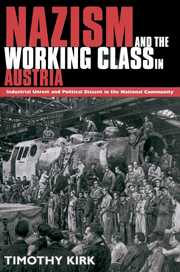 Nazism and the Working Class in Austria
Nazism and the Working Class in Austria Book contents
- Frontmatter
- Contents
- List of tables
- Acknowledgements
- Maps
- Introduction
- 1 Austrian fascisms, ‘Austrofascism’ and the working class
- 2 Economic integration and political opposition between the Anschluss and the war
- 3 The war economy and the changing workforce 1939–1945
- 4 Work discipline in the war economy
- 5 Popular opinion and political protest in working-class communities
- Conclusion
- Notes
- Select bibliography
- Index
5 - Popular opinion and political protest in working-class communities
Published online by Cambridge University Press: 06 January 2010
- Frontmatter
- Contents
- List of tables
- Acknowledgements
- Maps
- Introduction
- 1 Austrian fascisms, ‘Austrofascism’ and the working class
- 2 Economic integration and political opposition between the Anschluss and the war
- 3 The war economy and the changing workforce 1939–1945
- 4 Work discipline in the war economy
- 5 Popular opinion and political protest in working-class communities
- Conclusion
- Notes
- Select bibliography
- Index
Summary
Much of the discussion in the preceding chapters has shown that the concept of the Betriebsgemeinschaft (‘factory community’), which was at the centre of Nazi industrial relations policy, was little more than an artificial construct used by Nazi ideology and propaganda to cover the persistent underlying conflicts in industrial relations during the Third Reich. In this respect the experience of Austria was not significantly different from that of the rest of ‘Greater Germany’. The relationship between employers and workers was a tense one, and the decisive factor in maintaining industrial peace was repression. The ‘Betriebsgemeinschaft’ was, of course, merely an extension of the more general ideological construct of the Volksgemeinschaft (‘national community’), and relations in the workplace reflected similar relationships outside.
The aim of the ‘national community’ (as of the ‘factory community’), was to transcend, or more realistically, to neutralise social conflicts and create a society whose first loyalty would be to the racially determined nation (Volk) rather than to any particular interest. Existing loyalties to class, confession and region presented natural barriers to the creation of such a community and to the development of the νölkisch consciousness which would sustain it, and the regime sought to break them down, not least by discouraging the development of any form of solidaristic association within working-class communities. Of course, the restrictions on freedom of expression and assembly which this entailed were not limited either to the industrial working class or to the political Left, but it was from this quarter that serious opposition was most feared: workers, in view of their numbers, cohesion and political sympathies, were still potentially Nazism's most serious opponents.
- Type
- Chapter
- Information
- Nazism and the Working Class in AustriaIndustrial Unrest and Political Dissent in the 'National Community', pp. 109 - 134Publisher: Cambridge University PressPrint publication year: 1996
